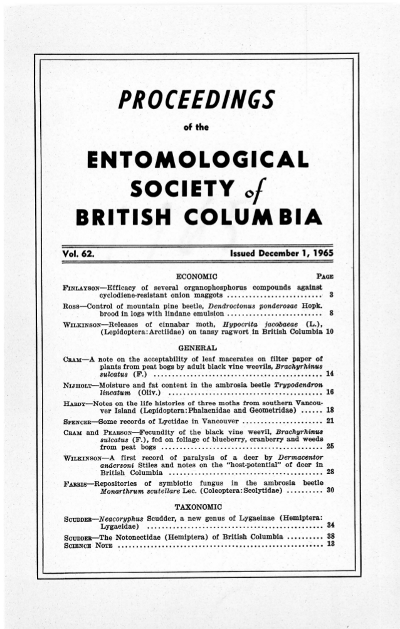A first record of paralysis of a deer by <i>Dermacentor andersoni</i> Stiles and notes on the "host-potential" of deer in British Columbia
Keywords:
<i>Dermacentor andersoni</i>, tick paralysis, deerAbstract
n/aReferences
Bishopp, F.C. and H.L. Trembley. 1945. Distribution and hosts of certain North American ticks. J. Parasitology 31 1-54.
Cooley, R.A. (1938). The genera Dermacentor and Otocentor (Ixodidae) in the United States, with studies in variation. U.S. Nat. Inst. Health Bull. 171:89 pp.
Cowan, I. McTaggart. 1944. Parasites, Diseases and Injuries of Game Animals in Banff, Jasper, and Kootenay National Parks. Canada Dept. of Mines and Resources.
Gregson, J.D. 1958. Host susceptibility to paralysis by the tick Dermacentor andersoni Stiles (Acarina: Ixodidae). Canad. Ent. 90(7):421-424.
Klebenow, D.A. 1965. A montane forest winter deer habitat in Western Montana. J. Wildl. Mgmt. 29:27-33.
Milne, A. 1949. The ecology of the sheep tick, Ixodes ricinus L. Host relationships of the tick. Parasitology 39:167-172.
Riek, R.F. 1962. Studies on the reactions of animals to infestations with ticks. Aust. J. Agric. Res. 13:532-550.
Trager, W. 1939. Acquired immunity in ticks. J. Parasitology 25:57-81.
Wilkinson, P.R. 1962. Selection of cattle for tick resistance, and the effects of herds of different susceptibility on Boophilus populations. Aust. J. Agric. Res. 13:974-983.
Wilkinson, P.R. 1964. Factors affecting distribution of the Rocky Mountain wood tick (Dermacentor andersoni Stiles) in British Columbia. (Abstract). Bull. Ecol. Soc. America 45:53.
Downloads
Published
Issue
Section
License
Authors who publish with the Journal of the Entomological Society of British Columbia agree to the following terms:
-Authors retain copyright and grant the journal right of first publication with the work simultaneously licensed under a Creative Commons Attribution License that allows others to share the work with an acknowledgement of the work's authorship and initial publication in this journal.
-Authors are able to enter into separate, additional contractual arrangements for the non-exclusive distribution of the journal's published version of the work (e.g., post it to an institutional repository or publish it in a book), with an acknowledgement of its initial publication in this journal.
-Authors are permitted and encouraged to post their work online (e.g., in institutional repositories or on their website) prior to and during the submission process, as it can lead to productive exchanges, as well as earlier and greater citation of published work (See The Effect of Open Access).


